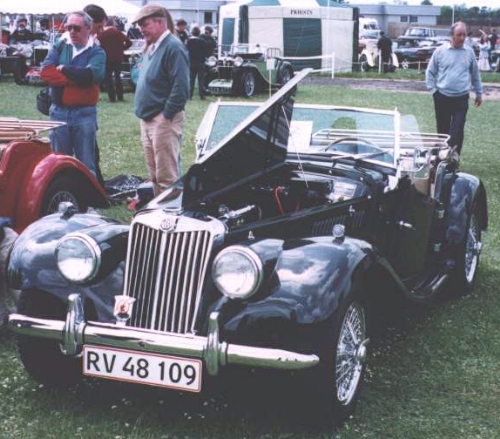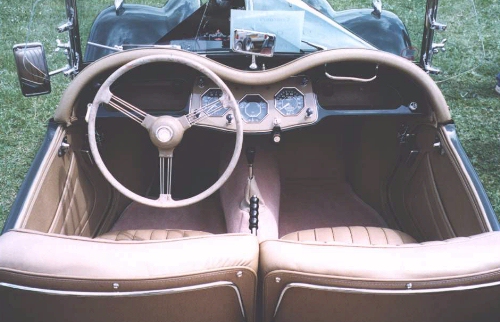For links go back to MG page
MG Page:Main Page:
MG TC:
MG TD:
MGA:
MGB:
MGB GT:
Spridget:
MGR V8:
MGF:
Engine: 1250 cc pushrod inline 4 cylinder water cooled. Bore/Stroke: 66.5 x 90 mm. Compression Ratio: 8 to 1. Max Horsepower: 57 bhp at 5500 rpm. Max Torque: 65 lb/ft at 3000 rpm. Fuel Delivery: Twin semi-downdraft 1.5" SUs Transmission: Four speed manual. Synchromesh: Top three gears. Clutch: Single dry plate. Frt Suspension: Independent coil and wishbone. Rr Suspension: semi-elliptic springs with Luvax Girling dampers. Wheelbase: 7' 10" Track: 3' 11 3/8" front / 4' 2" rear. Brakes: Lockheed 9" drums front and rear. Wheels: Bolt on disc (standard) Center-lock wire (optional) Tires: 5.5 x 15 inch. Performance: Acceleration 0-60: 20 seconds. Top Speed: 82 mph. Fuel Economy: 25 mpg. Number built: 9600 total (1250 and 1500)
Engine: 1466 cc pushrod inline 4 cylinder water cooled. Bore/Stroke: 72 x 90 mm. Compression Ratio: 8.3 to 1. Max Horsepower: 63 bhp at 5000 rpm. Max Torque: 76 lb/ft at 3000 rpm. Fuel Delivery: Twin semi-downdraft 1.5" SUs Transmission: Four speed manual. Synchromesh: Top three gears. Clutch: Single dry plate. Frt Suspension: Independent coil and wishbone. Rr Suspension: semi-elliptic springs with Luvax Girling dampers. Wheelbase: 7' 10" Track: 3' 11 3/8" front / 4' 2" rear. Brakes: Lockheed 9" drums front and rear. Wheels: Bolt on disc (standard) Center-lock wire (optional) Tires: 5.5 x 15 inch. Performance: Acceleration 0-60: 16 seconds. Top Speed: 88 mph. Fuel Economy: 23 mpg. Number built: 9600 total (1250 and 1500)
Launched at the 1953 Motor Show at London, the MG TF was meant merely as an interim model. British Motor Corporation management needed a car to fill the gap between the TD and the new MGA. Upon its introduction, the TF was critiqued as being old fashioned in a modern world. The sports car enthusiast had moved past the square rigged MGs and looked towards the Triumph TR and Austin-Healey 100 as modern and stylish. Needless to say, the TF improved on the TD in both its performance and classic appeal. The new sleek, yet still square-rigged styling was both attractive and more aerodynamic than its predecessor. The new dashboard was cheaper to produce and its octogonal gauges appealed to the MG purist. Other improvements to the car included faired-in headlights, a sloping radiator grille that hid a separate radiator, a more sloped rear, with the classic separate fuel tank, a different hood opening arrangement that proved frustrating to do-it-yourselfers, and the return of wire wheels (optional at extra cost). Interior improvements included the octogonal gauges, individually reclining seats, and a glove box for the driver and passenger. Complaints about the interior included the tachometer was too far away to read on RHD models and the lack of a fuel gauge (imagine that). The performance of the car centered on its fantastic handling but the TF was beaten into the ground by its competitors in acceleration and top speed. It became evident in the summer of 1954 that more power was needed. This came in the form of a bored out 1466 cc "1500" model. The total increase in power was about 10 percent. It was still much slower than the competition but the increase in power boosted sales in the American market. In 1955 the MG TF 1500 was dropped and MG was changed forever by the introduction of the MGA.


You are visitor number to the MG TF 1250 and 1500